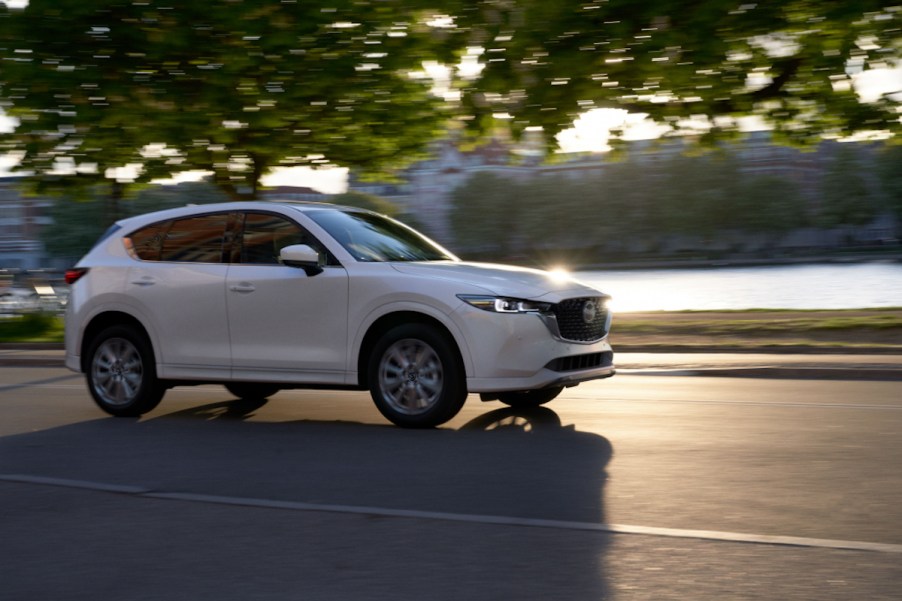
The 2022 Mazda CX-5 Boasts Winter Advantages
When winter weather hits, driving can get unpredictable. Many motorists rely on all-wheel-drive vehicles for navigating snowy and icy roads. And the 2022 Mazda CX-5 — now with AWD as a standard feature — comes just in time for the season. However, not everyone agrees AWD is all you need to navigate snowy and icy conditions.
The 2022 Mazda CX-5 has AWD plus other perks for winter driving

An upgrade over the previous model year, the 2022 Mazda CX-5 comes standard with all-wheel drive on every trim. The new model also has a redesigned grille, 19-inch alloy wheels, and a sculpted exterior.
The CX-5 offers a whopping eight trim levels: 2.5 S, 2.5 S Select, 2.5 S Preferred, 2.5 S Carbon Edition, 2.5 S Premium, 2.5 S Premium Plus, 2.5 Turbo, and 2.5 Turbo Signature. A 2.5-liter four-cylinder engine, producing 187 hp and 186 lb-ft torque at 4,000 rpm, powers the non-turbo models. The turbo models pack a turbo-four harnessing 256 hp and 320 lb-ft torque at 2,500 rpm, according to Mazda.
All trims also come standard with i-Activ AWD. This dynamic system adds traction to the wheels on the fly by monitoring various systems while driving. Before this year, that feature was available only on the range-topping CX-5 models.
Another new addition to the 2022 Mazda CX-5 is Mi-Drive (Mazda Intelligent Drive Select). The system lets drivers tweak settings for comfort and stability based on road conditions. For 2022, Mazda has updated the Normal, Off-road, and Sport modes for more connected performance. Mi-Drive is now standard on all trim levels.
Aside from performance, every 2022 Mazda CX-5 model also comes with heated front seats, a huge perk in the wintertime. Optional heated front seats and a heated steering wheel are also available.
But just because the CX-5 has AWD, don’t assume that feature can replace winter tires when driving on snow and ice.
AWD vs. 2WD with winter tires
There’s been a debate about which is better for driving on snow and ice: AWD or FWD with winter tires? TyreReviews set up two Mini Coopers In a head-to-head test to find out. It turns out FWD vehicles with winter tires stop faster and can slow down more to take corners. Winter tires also provide more grip than all-wheel drive.
Plus, AWD vehicles are heavier than two-wheel-drive vehicles. That makes them less fuel-efficient and, thus, more expensive to operate. Overall, the review recommends going with all-wheel drive and all-season tires for good cornering and traction. But a 2WD vehicle with winter tires is better if you’re driving around town and braking more often.
Which is better for driving in the snow?
All-wheel drive is helpful in the snow, but it’s really about getting going from a dead stop, not so much about steering and braking. Many people make this mistake when driving in the snow. During a test in unplowed conditions, Consumer Reports testers found that in certain braking and cornering conditions, all-wheel drive didn’t help.
They discovered that winter tires were more effective than AWD on snow and ice. The main reason people choose not to use winter tires is the inconvenience of changing them once a year. But if you live in a snowy climate, it’s probably worth it. However, all-wheel drive with good all-season tires will probably be fine on well-plowed streets.
According to Car and Driver, you shouldn’t rely solely on your tires to drive safely in the snow. Remember to drive smoothly when steering and accelerating because jerky movements can cause your vehicle to lose traction. If your car has a stability-control alert system, watch for warning lights to know when to ease off the accelerator.
CR’s testers also caution against being overconfident if you have an AWD vehicle when driving in the winter. AWD and 4WD cars work by sending power to all four wheels, which helps with acceleration on slippery surfaces. The critical thing to remember is AWD doesn’t improve steering in the snow, and it will brake like any other vehicle.


